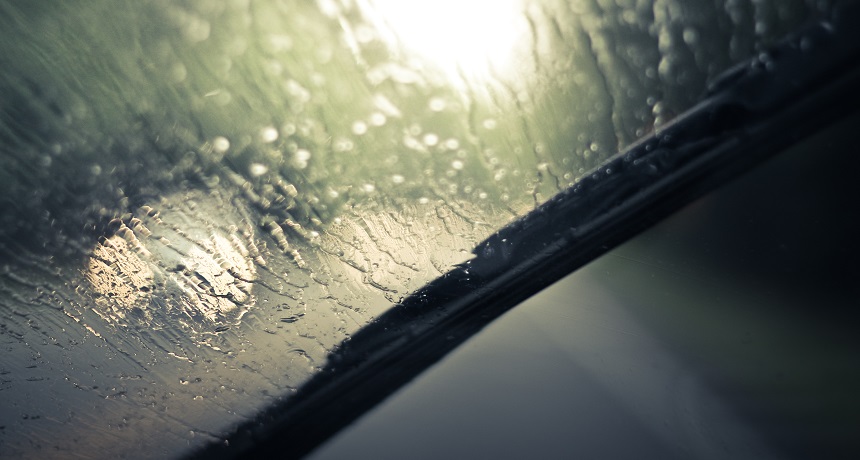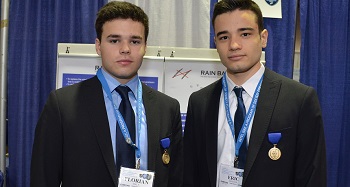Teens want to make windshield wipers obsolete
High-speed airflow could one day block raindrops from touching a vehicle’s windshield

Windshield wipers today are an essential part of a vehicle’s safety equipment. One day, however, high-speed airflow from well-placed nozzles might block any rain from reaching the glass.
Basheer Tome/Flickr (CC-BY 2.0)
Share this:
- Share via email (Opens in new window) Email
- Click to share on Facebook (Opens in new window) Facebook
- Click to share on X (Opens in new window) X
- Click to share on Pinterest (Opens in new window) Pinterest
- Click to share on Reddit (Opens in new window) Reddit
- Share to Google Classroom (Opens in new window) Google Classroom
- Click to print (Opens in new window) Print
By Sid Perkins
PITTSBURGH, Pa. — Windshield wipers are a key part of a vehicle’s safety equipment. They sweep raindrops and snowflakes off the glass so drivers can clearly see the road, pedestrians and more. But one day high-speed flows of air from well-placed nozzles might prevent precipitation from ever striking the windshield. Indeed, that’s the idea behind a new technology designed by a pair of 16-year-old inventors.
Windshield wiper blades eventually wear out, say Eric Breuer and Florian Maly. These 11th-graders attend École Privée Notre-Dame Sainte-Sophie in Luxembourg’s capital city, Luxembourg. Yet even when new, wipers sometimes can’t keep up with heavy rains. And wipers have another downside, says Eric. They can be an ugly part of an otherwise beautiful car. So, he and Florian came up with an alternative.

The pair tested their ideas in a wind tunnel on a 1/18-scale model of a car. Researchers use wind tunnels to study the flow of air over and around a solid object, such as an airplane or other vehicle. To simulate rainfall while driving, the teens turned a spray of water from a hose onto their model car.
In the first version of their system, the teens drilled several small holes into the side of the plastic tube that normally holds ink in a pen. Then they attached that tube to the lower part of the model car’s windshield. When they blasted air through the tube, it didn’t work, the teens recall. With probing, they realized all of the air had rushed to the end of the tube. It emerged from the last hole instead of spewing evenly out of each hole.
BLOW OFF High-speed airflow from a broad, flat nozzle keeps simulated raindrops off the windshield of this one-eighteenth-scale model of a car. Eric Breuer and Florian Maly |
Their redesigned nozzle instead used two plates of metal separated by a small distance. (In their model system, the gap between the plates was as thick as eight stacked sheets of aluminum foil would be.) Now, the air spews from one long, narrow slot that’s as wide as the windshield. When the teens forced high-pressure air though this new nozzle, the system worked. It blew air evenly all across the model car’s windshield.
Eric and Florian provided details of their new device at the 2015 Intel International Science and Engineering Fair. This event was created by the Society for Science and the Public (which also publishes Science News for Students) and is sponsored by Intel. The annual competition brought 1,702 finalists to Pittsburgh this year. They came from more than 70 countries.
For a wind speed of 50 kilometers per hour (31 miles per hour), the nozzle worked best when blowing up and forward at an angle of 45 degrees, the teens found. When moving at some other speed, a different angle might work better, Eric and Florian say. So any system installed on an actual vehicle would need to be adjustable. The angle could easily be controlled by an on-board computer and change with the vehicle’s speed.
Eric and Florian named their system RAIN BAN. Their tests show that it effectively prevents drops of water from hitting a windshield. But in their tests, the simulated raindrops were coming from a head-on direction only, the teens note. To guard against spray from the side, such as from vehicles passing in the next lane, engineers might need to add on a few extra, sideways-spewing air nozzles, the young researchers say.
Power Words
(for more about Power Words, click here)
engineer A person who uses science to solve problems. As a verb, to engineer means to design a device, material or process that will solve some problem or unmet need.
nozzle A round spout or slot at the end of a pipe, hose or tube. Nozzles are typically used to control the flow of a jet of high-pressure liquid or gas.
simulate To deceive in some way by imitating the form or function of something. A simulated dietary fat, for instance, may deceive the mouth that it has tasted a real fat because it has the same feel on the tongue — without having any calories. A simulated sense of touch may fool the brain into thinking a finger has touched something even though a hand may no longer exists and has been replaced by a synthetic limb. (in computing) To try and imitate the conditions, functions or appearance of something. Computer programs that do this are referred to as simulations.
Society for Science and the Public (or SSP) A nonprofit organization created in 1921 and based in Washington, D.C. Since its founding, SSP has been not only promoting public engagement in scientific research but also the public understanding of science. It created and continues to run three renowned science competitions: The Intel Science Talent Search (begun in 1942), the Intel International Science and Engineering Fair (initially launched in 1950) and Broadcom MASTERS (created in 2010). SSP also publishes award-winning journalism: in Science News (launched in 1922) and Science News for Students (created in 2003). Those magazines also host a series of blogs (including Eureka! Lab).
technology The application of scientific knowledge for practical purposes, especially in industry — or the devices, processes and systems that result from those efforts.
wind tunnel A facility used to study the effects of air moving past solid objects, which often are scale models of real-size items such as airplanes and rockets. The objects typically are covered with sensors that measure aerodynamic forces like lift and drag. Also, sometimes engineers inject tiny streams of smoke into the wind tunnel so that airflow past the object is made visible.







